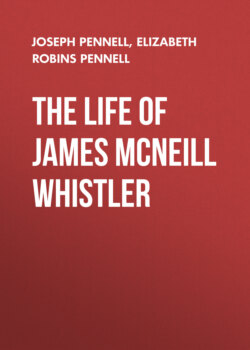Читать книгу The Life of James McNeill Whistler - Joseph Pennell - Страница 30
На сайте Литреса книга снята с продажи.
CHAPTER X: CHELSEA DAYS.
THE YEARS EIGHTEEN SIXTY-THREE TO EIGHTEEN SIXTY-SIX.
ОглавлениеTable of Contents
Whistler's first house in London was No. 7 Lindsey Row, Chelsea, now 101 Cheyne Walk. It adjoins the old palace of Lord Lindsey, which still stands, the original building divided into several houses, stuccoed and modernised, much of its stateliness gone, though the spacious stairway and part of the panelling have been preserved. Whistler's was a three-storey house, with a garden in front, humble compared with the palaces Academicians were building. "All these artists complain of nothing but the too great prosperity of the profession in these days," Hamerton wrote to his wife; "they tell me an artist's life is a princely one now." But Whistler lived his own life, and from his windows he could paint what he wanted. Only the road separated the house from the river; opposite was Battersea Church and a group of factory chimneys; old Battersea Bridge stretched across, and at night he could see the lights of Cremorne.
At the end of the Row the boat-builder Greaves lived. He had worked in Chelsea for years. He had rowed Turner about on the river, and his two sons were to row Whistler. One of the sons, Mr. Walter Greaves, has told us that Mrs. Booth, a big, hard, coarse Scotchwoman, was always with Turner when he came for a boat. Turner would ask Greaves what kind of a day it was going to be, and if Greaves answered "Fine," he would get Greaves to row them across to Battersea Church, or to the fields, now Battersea Park. If Greaves was doubtful Turner would say: "Well, Mrs. Booth, we won't go far," and afterwards for the sons—boys at the time—Turner in their memory was overshadowed by her. They had also known Martin, the painter of big Scriptural machines, whose house was in the middle of the Row. It had a balcony, and on fine moonlight nights, or nights of dramatic skies, Greaves or one of the sons would knock him up, and keep on knocking until they saw the old man in his nightcap on the balcony, where he would get to work and sketch the sky until daylight. Greaves remembered, too, Brunel, who built the Great Eastern, living at the end of the Row. Of other associations, dating a couple of centuries before, the little Moravian graveyard at the back was a reminder, for Lindsey Palace was one of the first refuges of Zinzendorf and the Brotherhood. A hundred years or so later Mrs. Gaskell was born there. The Row, indeed, was a place of history. But Whistler was to make it more famous.
[Pg 76a]
